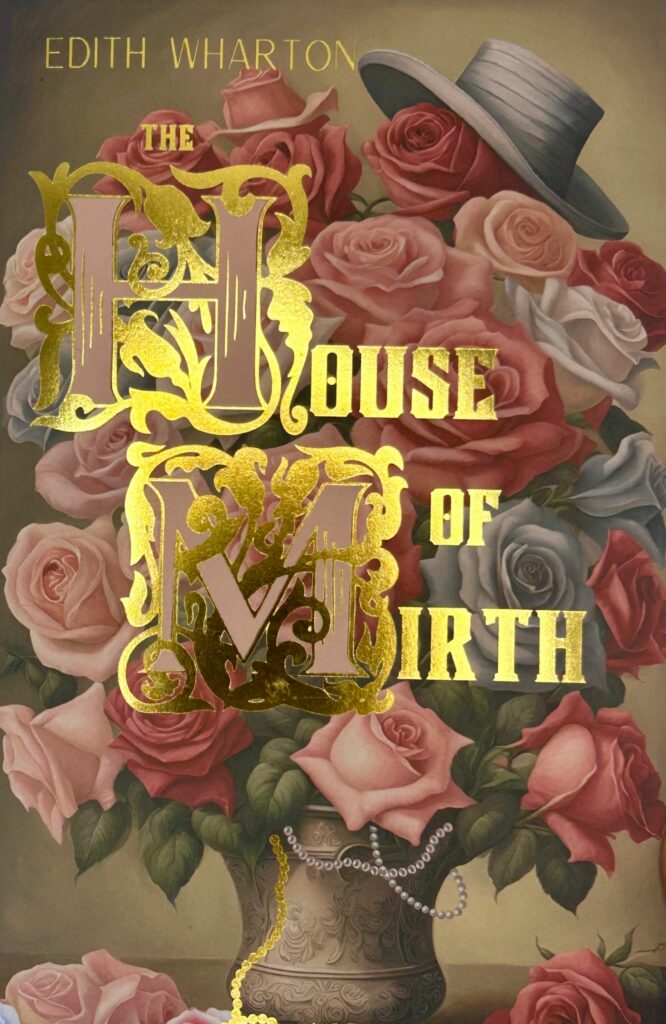
Mia Forbes looks at The House of Mirth
Mia Forbes looks at Edith Wharton’s mercilessly frank view of 19th-century New York society.
Attempts to recall the exact plot of The House of Mirth – whether Rosedale proposes to Lily before or after Bertha begins her affair with Ned, etc. – are often futile. The narrative is comprised of innumerable exchanges, alliances and conflicts that tend to blur into an indistinguishable series of social victories and defeats. With its fast-paced narrative developments, Edith Wharton’s novel effectively evokes the atmosphere of elite America at the turn of the 20th century, in which friendships form and break at a disarming pace, and it is often difficult to distinguish between compliment and slur, celebration and condemnation. This rapidly-shifting world is one with which Wharton was very familiar, being a New York debutante whose family are said to be the very Joneses with whom, before the ascension of the Kardashians, it was most fashionable to “keep up”.
The novel’s protagonist, Lily Bart, is another such young woman and is hardly the sort of figure likely to evoke the immediate sympathies of a modern reader. Influential, well-bred and beautiful, she reigns atop the social milieu with fierce independence, disparaging all the bachelors who dare to seek her hand. And yet, despite being so evidently discontent with the aristocratic marriage market, Lily is nonetheless willing to exploit its customs when it suits her. Her independent spirit and defiant charm are compromised in our eyes each time she uses the social mores to her own fleeting advantage, by accepting invitations, feigning flattery and entertaining unwanted suitors to advance her position. The fact that she indulges in the very behaviour she inwardly despises makes it difficult for the reader to place her as a rebel, a heroine actively resisting the oppressive forces of her environment. Nor is she entirely their victim, however, as she has countless opportunities for self-promotion and improvement, all of which she fails to capitalise on because of her own miscalculations or indecision. For this reason, a sense of self-sabotage haunts Lily’s narrative: in believing herself so above the community she silently scorns, she eventually finds herself cast down from its ranks to lows which she had hardly contemplated. Wharton invites the audience to consider how far this is the self-inflicted fall of a narcissist or the pitiful decline of a woman subjected to social persecution.
Lily navigates the Victorian world of reputation and status by closely guarding her identity, instead presenting her peers with a facade, performing whichever version of ‘Miss Bart’ she thinks most likely to win her the favours and impressions she seeks. This act reaches its climax during a pivotal scene in which Lily is transformed into a living portrait, a tableau vivant, for the entertainment of her fellow aristocrats. This parlour game exemplifies the Victorian obsession with image and appearance, which is literalised when the curtains are lifted and Lily is revealed in all her beauty, posing as the subject Reynolds’ portrait, Mrs Lloyd. In a society in which women were expected to maintain their modesty while simultaneously exhibiting themselves as desirable wives, the tableaux vivants phenomenon plays much the same role as Halloween does in modern culture, at least according to Mean Girls: “Halloween is the one night a year when a girl can dress like a total slut, and no other girls can say anything about it”. Likewise, Lily takes the opportunity to flaunt herself, relishing the attention lavished upon her by the spectators:
“Her dramatic instinct was roused by the choice of subjects, and the gorgeous reproductions of historic dress stirred an imagination that only visual impressions could reach. But keenest of all was the exhilaration of displaying her own beauty under a new aspect: of showing that her loveliness was no mere fixed quality, but an element shaping all emotions to fresh forms of grace.”
Indeed, this display of beauty is met not only with the admiring gasps of her peers, but also with a confession of love from her old (and very eligible) friend Lawrence Selden. Agonisingly, for the reader, Lily rejects his implied proposal after kissing him, and leaves without explanation. The initial success of the stunt is further undermined the next day when Lily is invited to dinner by her friend Judy Trenor, but arrives only to be cornered by Judy’s husband, Gus, to whom she had entrusted her last $10,000 to invest on her behalf. Jealous of her public exhibition, Gus had deemed Lily’s tableau vivant to be in “damned bad taste”, and now calls in the favours he expects of her. She answers his euphemisms with pleas of naivité and flees the house, but is spotted by Selden and a friend, who assume the worst: that Lily has been repaying Gus’ financial assistance with sexual favours. The next day, Lily appeals to her aged aunt for money but her request is rejected. Spontaneously (and somewhat disingenuously, we might think) Lily experiences a sudden change of heart regarding Selden, and eagerly awaits his call, unaware that he had seen her leaving the Trenors’. She is dismayed to discover that he has gone abroad without notice.
Disappointed at Selden’s departure and desperate to escape the unwanted advances of both Gus Trenor and Simon Rosedale, a nouveau riche banker who pursues her throughout the novel, Lily disappears from New York to join friends on a European cruise. In accepting their invitation, she unwittingly propels herself into a ruinous series of social faux pas that see her reputation decimated. All attempts to cling on to an elite lifestyle fail, and Lily finds herself working first as a secretary and then as a milliner. Despite the pride she had taken in her craftsmanship when altering party outfits was little more than a leisurely pastime, here she discovers that her actual skills fall far short of the standards held by the working class, a realisation that sends her further into her depression. The versatility with which she navigated the upper strata of New York society fails her, and she struggles to adapt to her new station, becoming increasingly reliant on sedatives.
And yet, given that it was earlier said of the protagonist that “her whole being dilated in an atmosphere of luxury; it was the background she required, the only climate she could breathe in”, Lily does endure poverty staunchly for a time, refusing to compromise her loyalties to Selden and still resolutely unwilling to form an allegiance with the wealthy Rosedale. When she finally comes into a large inheritance, she does not use it to regain any sort of social status but instead chooses to pay back Gus Trenor. Just as we begin to feel that our heroine may have turned a corner, that her actions are now driven by a sense of duty rather than by egoism, disaster strikes: Lily dies of an overdose, whether suicide or accident, Wharton never specifies. To complete the tragedy, Selden arrives the next morning ready to propose a marriage which, we must surely assume, Lily would have finally accepted. The novel ends:
“He knelt by the bed and bent over her, draining their last moment to its lees; and in the silence there passed between them the word which made all clear.”
Whatever this “word” is, it does not clarify much for the reader; we are at a loss for how to react to this sudden ending. On the one hand, it is the finale that we have anticipated all along since from the beginning Wharton highlights to us the weaknesses and insecurities that Lily strives to hide from her peers. Her obvious proclivity towards fabrication suggests that her story will be tinged with tragedy, that she will ultimately orchestrate her own undoing. On the other hand, however, we often find ourselves taken aback by Lily’s impulsive behaviour, as she suddenly switches between pursuit and flight, enthusiasm and disdain. These vacillations make her inherently unknowable, her actions impossible to predict. As much as we are permitted access to her sincere thoughts and feelings, then, there is nonetheless a part of Lily’s character that remains just as obscure to the audience as it is to her fellow socialites. We are left wondering why she constantly sought that which “at heart, she despises”, and how such an energetic and defiant young woman allowed herself to become so utterly defeated by her circumstances. Perhaps only when looking back over her life, after the shock of her death, can we appreciate the meaning of the verse from which the novel takes its name:
“The heart of the wise is in the house of mourning; but the heart of fools is in the house of mirth.” — Ecclesiastes 7:4
Up until its conclusion, death and mourning are not prominent themes in The House of Mirth, and although her decline is a long time coming, Lily’s actual death strikes all of a sudden. With this abrupt ending, Wharton leaves her readers to dwell on the realities of high society, as she shows to what lows it can drive even its most celebrated stars. Alongside its illustrations of extravagant parties and luxurious soirees, the novel also includes some vignettes of ‘ordinary’ life, such as that of Gerty Farish, who enjoys a mundane existence at the peripheries of the plot. While Lily wilts in adverse conditions, Gerty endures hardship with a humble lifestyle, kind nature and modest expectations Her life, although hopelessly unglamorous, ultimately proves more stable, successful and happy than those of the elite. While the quick turns of fate and fluctuating fortunes of the upper class undoubtedly provide much excitement and drama, they also expose its members to enticing vices and dangerous risks. Edith Wharton may not have eschewed all of these hazards in her own life, but her novels certainly express an implicit criticism of the society that shaped her.
Image: Study in The Mount, Lenox, Massachusetts, the home of Edith Wharton, who designed the house and grounds.
Editorial credit: Shanshan0312 / Shutterstock.com
Books associated with this article
